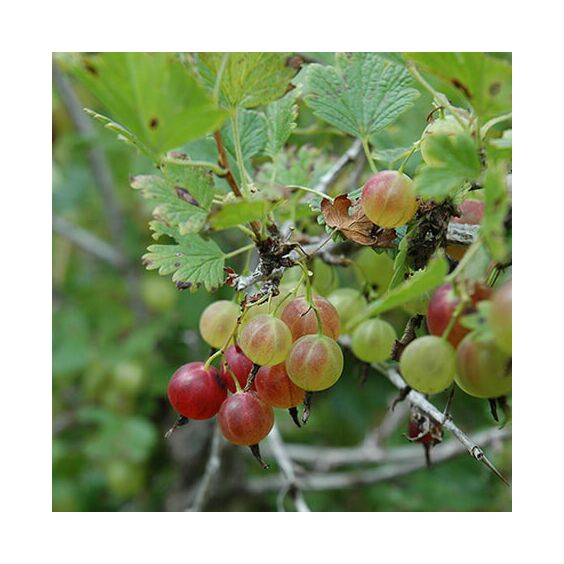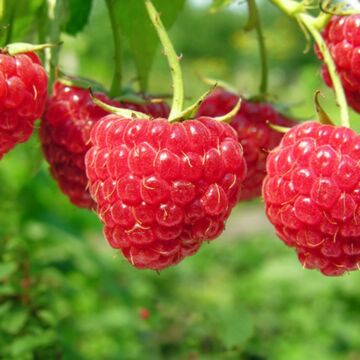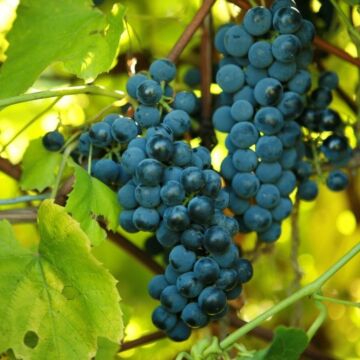
Growing zones
See Zone Map >Status: In stock
NOTE: #1 bare root size is around 6" tall and wide.
- Sun, Part Sun/Shade
Mature Plant Size (H x W): 3-4' x 3-4'
Bloom Season: Spring, Summer
- Attracts Bees
- Attracts Birds
- Edible to People
- Attracts Butterflies
- Attracts Pollinators
Planting & Care for Pixwell Gooseberry Bushes
Preparation
- Plant gooseberries in full sun—you'll get more fruit.
- Currants & gooseberries perform better in rich, well-drained soils.
- It's best to prepare your planting area the previous fall.
- Be sure to test your soil regarding pH levels.
- Add compost if needed.
- Gooseberry plants can handle temperatures as cold as 19 degrees Fahrenheit.
Opening Plant Material
- Your item will arrive as a bare-root plant. This means it's in a state of dormancy so it doesn't have any soil on the roots and foliage. This is normal. These are a way for us to offer you a healthier, more affordable, fresher plant year-round.
- Cut open the bundle (top and roots are tied) and separate all the plants.
Soak roots in buckets of water until planted. - Each plant type will be labeled separately for identification.
- Do not expose the roots to the sun. They should never dry out. Keep roots covered.
- All bare-root plants must be trimmed when planted. See "Pruning - After Planting" below.
Planting
- You can plant your Pixwell Gooseberry in April, May or September, October
- Plant in rich, well-drained soil
- Plant in full sun for more fruit
- Plant 3 feet apart from each other if you purchased more than one.
- Dig a hole at least 6" wider and the same depth as the root mass.
- The crown or graft of the plant should be slightly higher than ground level where it was grown at the nursery.
- Trim off the broken roots and branches.
- Place fertilizer packets in a hole (if purchased). Do not place other fertilizers in the planting hole. *Use our recommended fertilizer.
- Spread the roots and fill halfway with soil, then water until it settles, completely saturating the soil and planting pit.
- Re-adjust the plant and fill the hole with the rest of the soil.
- Backfill the balance of the soil and water well.
Pruning - After Planting
- Prune ALL bare root plants to reduce transplant shock and ensure success. Pruning should occur either before or as soon after planting as possible. All pruning should be done with a sharp pruning shears. See our handling guide for detailed pictures and instructions.
Pruning - Through-out the Season
- Prune annually to get rid of dead areas, which will allow for more growth by opening the canopy.
- Prune in late winter (early March) before new growth appears.
- Wait the first 3 years before pruning to allow for enough canes to grow. Only remove weak wood.
Watering - After Planting
- Plants typically take approximately 6 weeks to establish new roots in your soil. During this period, water plants as often as every 2-4 days at the start and at least a minimum of once per week.
- Beyond the 6 week establishment period, water once per week, unless rains occur.
- Stick your finger into the soil around 3” to check soil moisture.
Watering - Through-out the Season
- After the first season, plants should only be watered during extended periods without rain.
- How do you know if your plants need water? The easiest way to tell is to touch the soil around the roots. If it is moist, there is no need to water. If it is dry, give it a good soaking with the hose end (no nozzle) watering the soil only, not the leaves.
- Stick your finger into the soil around 3” to check soil moisture.
Planting & Handling Help
Download our Planting and Handling Guide below to plan for a successful arrival and install of your plants. Be sure to water all plants as soon as they arrive and every day until you’re ready to plant. Keep any bare root bundles in a shady, cool spot with the roots covered at all times.


Learn More
Watch our videos on handling bare root plants, how your order is prepared for shipment and more.


Plant Sizing
What is the difference between Containers, Grow Bags, Bare Root, and Balled & Burlap (B&B)?
Shipping Times


Our FedEx and local shipping times depend on two factors, one is by the region and the second is the type of product being shipped. For example, small fruits are only shipped in spring, but majority of our perennials are shipped from spring until fall. Keep in mind the dates below act as a general guide. Due to unpredictable weather, staffing, inventory and industry demands these timelines can change. Therefore, we cannot guarantee any of these times.
Shipping Dates by Region*
Northern Cold Region: April 22nd - November 7th
Northern Region: April 15th - November 7th
Middle Region: April 1st - November 7th
Southern Region: March 15th - November 7th
Local Delivery (small radius from Waterloo, WI): April 22nd - November 7th
Shipping Dates by Season*
Spring Shipping: Region Start Date (above) - May
Fall Shipping: September - November
Due to unpredictable weather, these times may vary. Some varieties are exceptions due to heat and plant health reasons. Enter your shipping zip code at the top of this page and be sure to check the shipping information on each product before you add it to your cart. If the product is too large or restricted in your state, you will not be able to checkout with that item in your cart.


